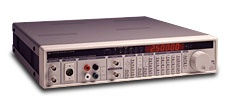
Request Information
Refurbished
The performance of a low distortion analog source and the precision of direct digital synthesis (DDS) is combined in the DS360. With less than 0.001 % total harmonic distortion (THD), 25 ppm frequency accuracy, and a broad range of features including sweeps and bursts, the DS360 is the ideal source for audio frequency applications. Frequency Stability Low-distortion analog sources have impressive THD specifications but suffer with poor frequency accuracy and resolution. The DS360 delivers 0.0025 % frequency accuracy over its entire frequency range. It also boasts 6-digit frequency resolution from 1 mHz to 200 kHz, and a steady 25 ppm frequency stability. You can actually dial in 123,456 Hz from the front panel and have it mean something! Waveforms The DS360 generates clean sine waves and square waves, as well as a two-tone signal for IMD testing. The two-tone signal is defined as either two sine waves, or a sine wave and a square wave. Both frequency and amplitude are independently set for the two waves allowing standard two-tone formats like SMPTE, DIM and CCIF to be generated. In addition to standard waveforms, the DS360 outputs white noise, pink noise and band-limited white noise. Audio Outputs All functions and parameters are easily set using the front-panel keypad and spin knob. A wide variety of amplitude units including Vrms, Vpp, dBV, dBm and dBrel can be selected. Front-panel outputs including XLR, BNC and dual banana jacks assure compatibility with any system. The outputs can be configured as balanced or unbalanced, with amplitudes from 20.0 Vpp to 80.0 Vpp (balanced), and 10.0 Vpp to 40.0 Vpp (unbalanced). Chassis ground and output common banana jacks are also provided. Rear-panel digital outputs (opt.) conform to AES-EBU and SPDIF/EIAJ formats. An XLR jack is provided for the AES-EBU output, and both fiber optic and coaxial connectors are provided for the SPDIF/EIAJ output. Sweeps and Bursts Unlike single frequency analog sources, the DS360 generates low-distortion frequency sweeps over its entire frequency range. Linear and log sweeps are set between 10 mHz and 200 kHz with sweep times between 0.3 ms and 100 s. Sweeps can be single-shot or repetitve, and the instrument can sweep both up and down in frequency. The DS360 provides outstanding amplitude flatness (0.5 % up to 20 kHz) during frequency sweeps, and has a TTL level sweep marker output for synchronizing external equipment. The DS360 also creates tone bursts of sine waves and square waves. The number of ON cycles, repetition rate, and the OFF amplitude level can all be adjusted. Sweeps and bursts may be triggered from the internal rate generator or an external trigger, or they can be externally gated. The DS360 is designed for benchtop use as well as automated testing. With standard IEEE-488.2 (GPIB) and RS-232 interfaces, the DS360 is fully computer programmable—a feature seldom found in low-distortion sources. All instrument functions can be controlled or queried through the computer interfaces. |
Stanford Research DS360 datasheet & specifications

